![]()
1955
On January 4th a blizzard affected much of southern England with some delays on the Southern Region Eastern area experienced during the evening rush hour, due to frozen points and ice on the rails. North of the Thames a complete failure of the electric signalling at Kings Cross coincided with the blizzard, both creating some delays.
Another blizzard struck on the afternoon of January 13th causing considerable delays to the services on the North Kent lines, with some steam substitutions. Services north of London were also impacted, the down West Coast Postal to Aberdeen arriving over three hours late on January 13th.
Bad weather at the end of January affected the operation of the diesel services in the Leeds/Bradford area. Frosty conditions led to burst radiators and water pipes, the failure of sanding gear causing severe slipping, requiring assistance from steam locomotives.
On February 16th & 17th heavy snows in the Scottish highlands blocked a freight train at Slochd and closed the line between Inverness & Wick due to blockages at Lairg & Altnabreac. The Far North line remained closed until at least February 21st.
The Isle of Man suffered from the heavy snows on February 24th/25th causing a morning Port Erin - Douglas train to take three and a half hours whilst the morning Ramsey - Douglas train took over nine hours.
On March 8th a single line on the Kirkby Stephen - Barnard Castle route was reopened after being closed due to the recent blizzards. Warnings were given to passenger that there were very limited clearances in the areas of the snow drifts, putting ones head out the window could result in potential injury. Freight traffic over this route had been redirected via Skipton. The same storm also closed the Middlesborough - Whitby coast line, trapping two locomotives and four wagons in drifts near Starbeck.
1958
January was a cold and snowy month, starting from the 19th with 15cm of snow over much of country, 40cm over northern Scotland & 25cm across Essex on 24th, a thaw set in from 26th.
Early December produced lengthy periods of intense fog. On the workings out of St Pancras, despite the fog, service delays were minimal. On the South Western Division on Christmas Eve fog delayed many services, not helped by many additional holiday extras being operated. On the Central Division, particularly in the Tonbridge area this fog affected evening rush hour services and later services too.
![]()
1959
The beginning of January saw heavy snow falls at the southern end of the Pennines, the prospect of more snow on the night of January 6th/7th saw a snowplough operating through the night on the Chinley - Hope line.
Dense fog on during January 28th & 29th caused problems on the Southern Region. At Esher on the evening of 28th the 10.30pm Waterloo - Weymouth rearended the 10.15pm Nine Elms - Plymouth freight, fortunately the damage was slight due to the slow speed.
Dense fog on the night of February 18th/19th did not help matters when empty coaching stock was derailed at Eastleigh South box, blocking the Eastleigh - Fareham line, single line working was introduced during the morning of 19th with both lines open later the same day.
On August 28th a severe storm in the late afternoon caused heavy flooding at Liverpool Street station, with four feet of water covering the approaches. It would take three hours before services resumed.
On October 26th high winds damaged the overhead line between Frinton & Kirby Cross, whilst a tree fell on the line near Wivenhoe. The next day (27th) D5020 was hit by a falling tree on the East Suffolk line.
Fog at the end of November into early December caused a number of operating headaches. On December 1st a two-car diesel multiple unit hit a car near Henlow in thick fog, regrettably the car driver was killed. Elsewhere on the Western Region out of Paddington, the fog delayed many trains, with timekeeping improving once away from the capital. On the Southern Region the fog service was enacted on December 2nd and remained in force all day.
![]()
1960
A number of failures on the Fenchurch Street - Southend passenger services on January 11th were not assisted by the intervention of a blizzard during the afternoon.
On January 12th snow in Kent caused some operating problems to the electrified passenger services, particularly in the Canterbury & Faversham areas.
Snow was reported in the West Midlands on January 13th.
The night of January 20/21st found blizzard conditions over the southern end of the Settle & Carlisle line. In these awful conditions an overnight up passenger train running just north of Settle suffered a fracture in its piston rod. This caused the derailment of 2-6-0 No. 42881 on a passing down freight, which then hit many of the coaches causing severe damage, leading to five passengers being killed. Despite the late hour and the appalling weather conditions the emergency services were on scene in twenty seven minutes.
In Scotland on January 21st the Dundee - Kingsmuir freight was double-headed by J36 65319 & J38 65922 due to the considerable amount of drifting snow.
Fog on the evening of January 26th caused some operating difficulties in eastern Kent.
Late September produced a period of heavy rain which led to serious flooding in the West Country. Trouble commenced during the early afternoon of September 30th on the former LSWR mainline west of Exeter between Newton St Cyres & Crediton. At Bridge 247 floodwater in the nearby river Creedy rose over nine feet above normal and swept the 35 foot span away. Whilst this was the most dramatic failure, the river Creedy caused damage at other locations along the railway making access for repair crews very difficult. After several days repairs had been made to the track formation sufficient to allow crews to reach the bridge piers, where, by Thursday October 6th repairs to the bridge structure were well underway. Unfortunately before further progress could be made a surge of flood water undid the previous week's work. Further rain fell on Saturday but by Wednesday October 12th repairs allowed for single line working over the temporary bridge.
This line closure nearly forced all Southern services to use a bus bridge between Exeter Central & Crediton. Services from Waterloo were quickly turned round at Exeter Central, whilst Crediton for a few days became a hive of activity probably never seen before! The first trains across the renewed Bridge 247 occurred during the late afternoon of Wednesday October 12th.
The Western Region mainline did not escape damage. At about the time that Bridge 247 collapsed the WR mainline flooded at Plympton and the Exeter Canal overflowed west of Exeter, leaving only the up line usable until Monday October 3rd. During the flooding the Western Region banned the use of diesels on those lines that suffered flooding.
The heavy rains and flooding that swept away Bridge 247 west of Exeter also caused problems on the LSWR mainline east of Exeter on the night of Friday September 30th and the morning of Saturday October 1st. A landslip shortly after midnight on Honiton bank derailed a Waterloo - Plymouth newpaper train, blocking both lines. Heavy rains would hinder the repair work. Westbound services were stopped at Axminster whilst an Exeter - Honiton shuttle was instituted, though by Monday morning the down line was reopened.
Meanwhile not too far away on the Western Region mainline the River Culm was flooding in several places. The Culm Valley branch was closed by a washout near Whitehall Halt on the morning of Saturday October 1st. The dairy at Hemyock also flooded. However later in the afternoon the mainline was closed due to flooding at Hele & Bradninch. Up services were held at Exeter until some were routed via the Exe Valley branch to Tiverton & Tiverton Junction. Late in the afternoon the Up line was declared useable by steam locomotives, the Down main remained closed. Delays of two to three hours were typical. Further south at Newton Abbot a portion of the branch to Moretonhampstead was washed out, it would be several weeks before the washout was repaired. On Sunday October 2nd further flooding occurred at Plympton and at Teignmouth with traffic stopped for awhile before single line working was introduced. At about lunchtime on October 3rd a bridge on the Exeter - Exmouth branch at Exton was declared unsafe, it would remain closed for about forty eight hours.
Despite continued heavy rain throught the week the Southern Region mainline at Honiton bank reopened on Friday October 7th. Further localised flooding occurred in the West Country, but it tended to be of a minor nature with few serious service interruptions. Flooding of a different kind occurred on Saturday October 8th when high seas washed away ballast between Teignmouth & Dawlish. Services were allowed to pass the damaged sections at no more than 5mph.
The last week of October brought more heavy rains to the south-west and with it more flooding and line closures. Flooding again took place at Hele & Bradninch on the night of October 26th/27th. Other streams coming off Exmoor caused damage to the Barnstaple, Durston - Yeovil, Exe valley and Minehead branches. By Thursday morning single line working had been established at Hele & Bradninch, but at the same time floodwaters in the Exe were flooding the lines at Cowley Bridge Junction westwards towards Riverside Yard. Initially trains (powered only by steam locomotives) were handflagged through the flooded area, but more floodwaters from the Exe raised the levels even further and commenced to wash away ballast. Up trains were stopped at Exeter St Davids, down trains at Stoke Canon, with buses shuttling between the two points.
The floodwaters continued to rise and push towards Exeter St Davids, which was becoming very busy with many trains. Eventually trains were diverted over the LSWR route, though the reversals necessary at Exeter St Davids and the rising water levels did not make this a straightforward task. Delays were considerable and the high water levels precluded the use of diesel locomotives. The increasing depth of water slowly reduced the number of reversible roads that allowed access to the LSWR route, at one time only one such platform was available. Frequently all platforms were full and trains were waiting from one to two hours to reach a platform. Many Up trains had their diesels replaced by steam at Newton Abbot. At about 8pm it was noted that the water was no longer rising in the vicinity of Exeter St Davids.
The morning of October 28th saw enough lowering of water levels to reopen the WR Down line at Cowley Bridge, with two trains of ballast shuttling to and fro. Although the framework of a service was being re-established, the coaching stock diagrams were well and truly out of sorts. It would take many days to get the stock operating on the intended services.
Further east the storms that had plagued Devon also brought problems to Sussex & Surrey, but not of such a serious nature. That would occur during early November, when continuing rain created flooding and earth movement issues on the morning of November 3rd. On this day an early morning Eastbourne - Tunbridge Wells service left two coaches stuck in a muddy landslip at Argos Hill and saw the service terminate at Rotherfield due to flooding further north. Uckfield sustained serious flooding, followed shortly after by flooding near Isfield and Buxted. Some flooding in the Lewes area initially caused minor disruption to the services, but late on November 3rd a channelled swollen stream broke out of its course, causing much flooding including Lewes station with water up to platform level at some points. This led to the electric power being shut off, with busing being used though one steam powered Brighton - Eastbourne service did run late at night to connect with services from London.
The morning of November 3rd brought little change to the scene at Lewes station, whilst flooding had also affected the line at Glynde. Although the electric service had been suspended between Brighton and Eastbourne, a substitute steam service was started up using an incredible variety of rolling stock and locomotives. Electric trains were still running between Eastbourne and Ore, whilst services on the Seaford branch had been suspended. On Saturday November 5th the height of the water at Lewes station allowed the use of diesel powered units to be used on the passenger services. The Seaford branch was operating an electric service to Newhaven Town, the following day (6th) a steam service would operate through to Lewes.
By mid-morning on November 6th the floodwaters had subsided enough to allow the return of electric traction to the Brighton - Eastbourne & Lewes - Seaford routes. The line from Lewes to Uckfield & Cooksbridge remained closed until November 8th.
Storms in late November caused flooding in many places, including Methley, Matlock, Derby & Nottingham.
Somerset was hit by heavy rain on December 3rd & 4th with a landslide at Midford on December 4th closing the Somerset & Dorset line for about a week. Major flooding also occurred at Radstock. For local services a bus bridge operated between Radstock & Bath. The Pines Express was diverted via Salisbury, Westbury & Bath. Normal working was resumed by December 10th.
![]()
1961
Heavy snow fell in the West Country during January.
Early in 1961 gale force winds tested the recently installed WCML electrification equipment, which had been designed for winds up to 60mph. During gales at this time wind speeds exceeded 60mph causing displacement of the contact wire beyond the span of the pantograph, which then caught the dropper wires and pulled the catenary down onto the train. Following this the catenary, particularly on unprotected stretches of line in open country, was redesigned for wind speeds up to 120mph.
In December three days of heavy smog caused over 200 insulator flashovers on the Crewe area WCML lines. This phenomenon had occurred occasionally before at stations and tunnels where steam and smoke combined to coat insulators with very conductive products of pollution.
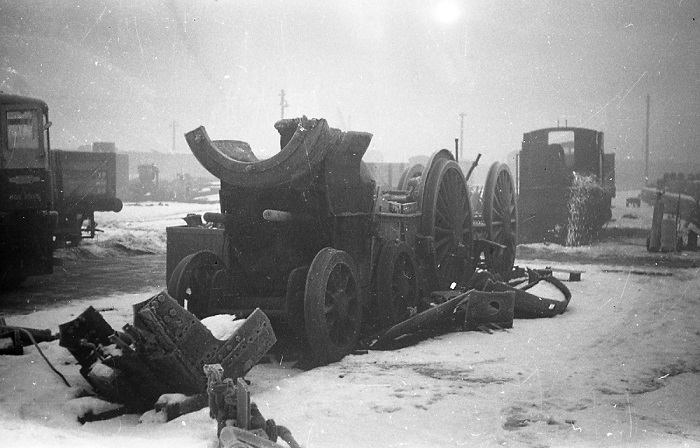

Just prior to the end of year snowfalls December 15th brought heavy fog particularly on the East Coast. In this fog late in the evening a serious derailment occurred near Wood Walton on the ECML. A rear end collision involving a Newcastle - Holloway ECS with D9012 and a New England - Kings Cross freight with V2 60803 threw debris across the running lines derailing V2 60977 with the Aberdeen meat train and A3 60078 on a down York fitted freight. Shortly before this, also in fog the 6.30pm Liverpool Exchange - York with 44929 collided with shunter D2589 at Healey Mills, blocking all lines for most of the night.
The last week of the year brought severe weather conditions to much of the country. The inactivity over the Christmas holidays allowed creation of huge icicles in many tunnels, in the Peak District Dove Holes & Cowburn tunnels suffered this. On Boxing Day the driver of a St Pancras - Manchester express suffered injury from icicles in Dove Holes tunnel, in Cowburn tunnel 42314 on the 7am Chinley - Sheffield suffered a damaged cab, the crew escaped injury though a replacement locomotive was needed for the return working.
In the London area on New Years Eve heavy snow crippled Waterloo in the evening rush hour, not helped by a chronic shortage of electric stock, with many services running with short formations and with little attempt made to follow the timetable. The Central Division suffered severe dislocation, taking several days to sort out the confusion, not helped by the loss of telephone communication in many areas. Brighton had received 30325 for snow clearance duties, but it was discovered the Brighton plough would not fit on this machine, it was sent off rather unsuccesfully on a Tunbridge Wells freight, it was soon returned to its home on the SW Division! On the Shenfield/Southend lines frozen points and immobilized stock created chaos. Such was the shortage of serviceable stock that twenty four units were borrowed from East Ham to enable some sort of service to operate over the LTS. On the services out of St Pancras the Peaks and diesel multiple units did not fare well with many failures and delays allowing much steam working to occur. It is to be presumed that the steam heating boilers were the chief cause of the locomotive failures. The Anglo Scottish services seemed to suffer the worst, with Royal Scots and Jubilees filling in.
The wintry weather on December 30th did not prevent many enthusiasts & locals coming out to see the last workings of the Bedford - Hitchin service. These last workings were handled by 84005 and two auto coaches. It also affected the last weekday working of steam operation over the Calder Vally route, frozen water trough did not help matters.
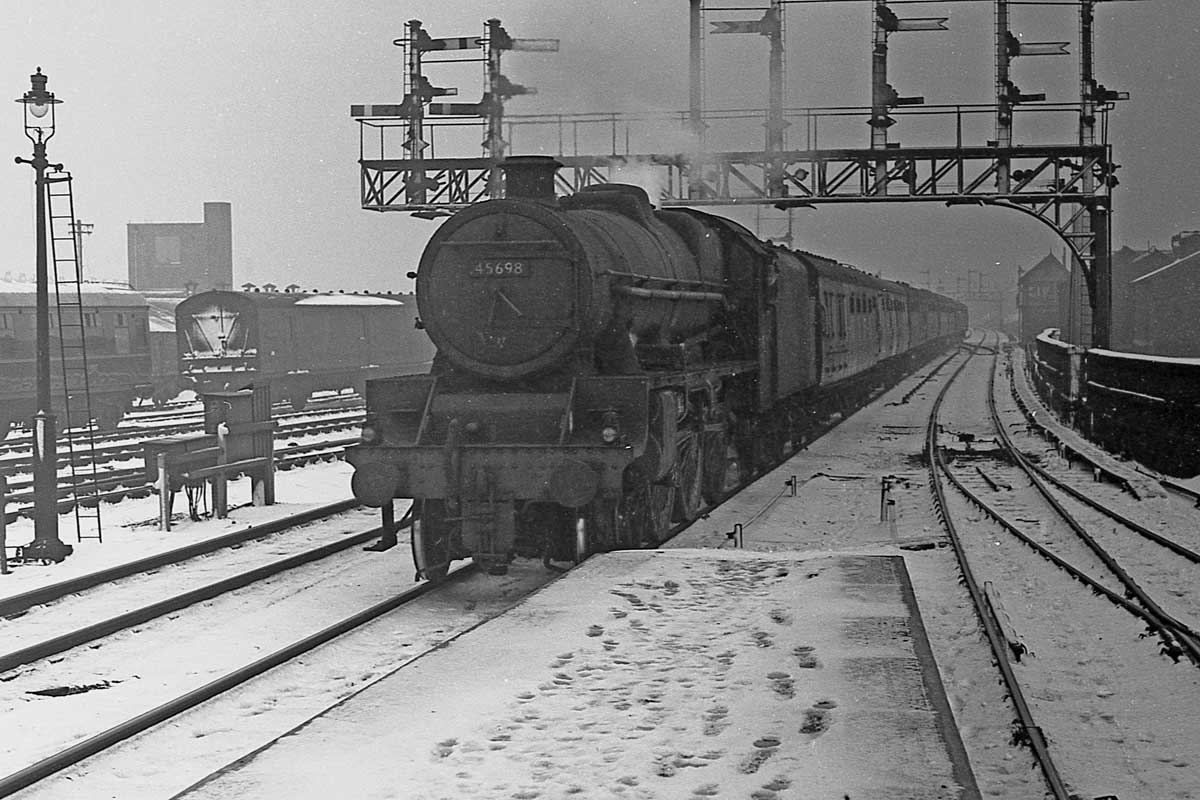
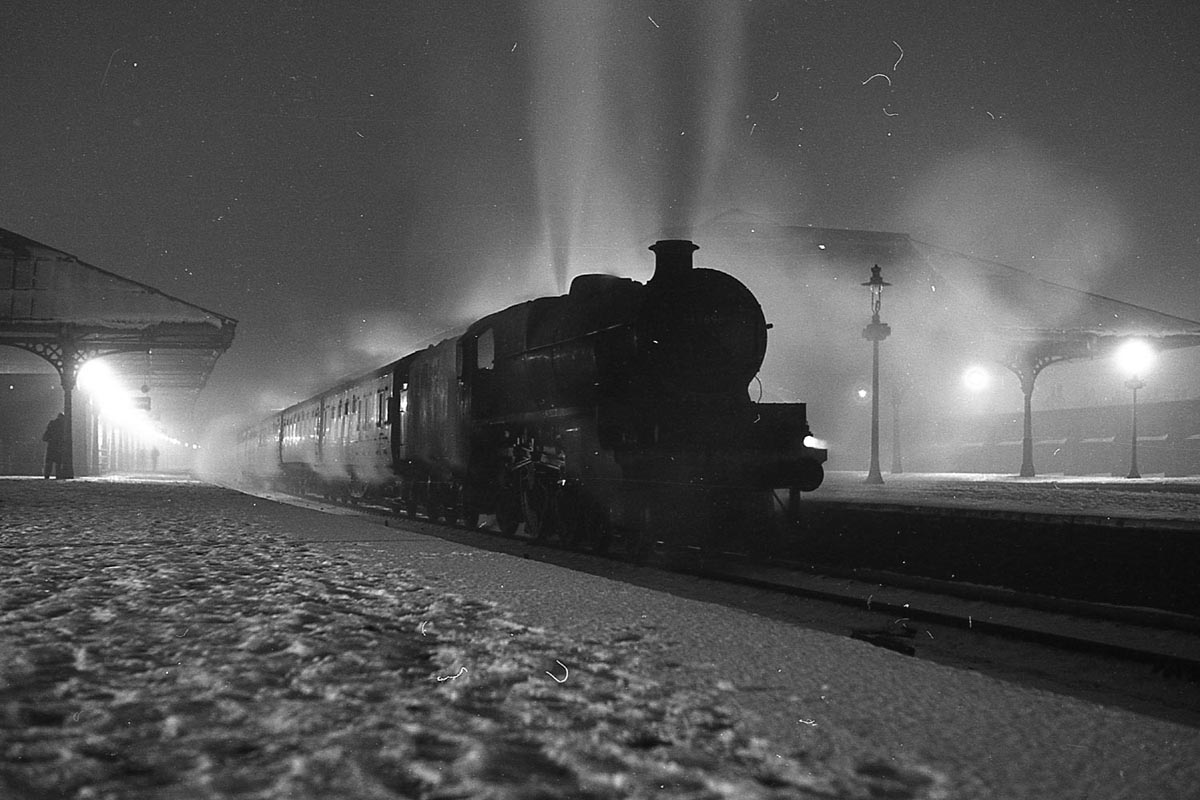
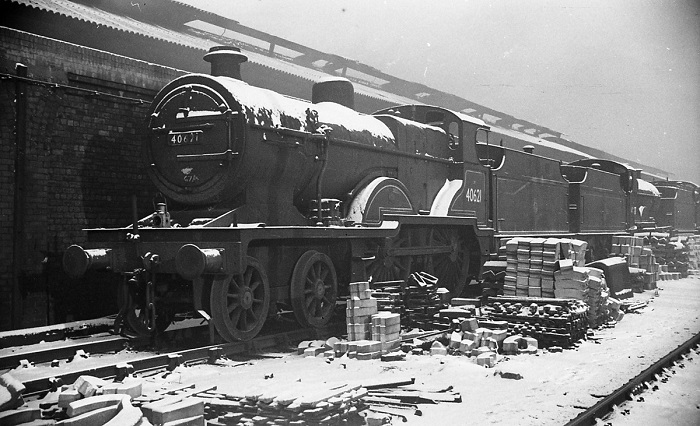
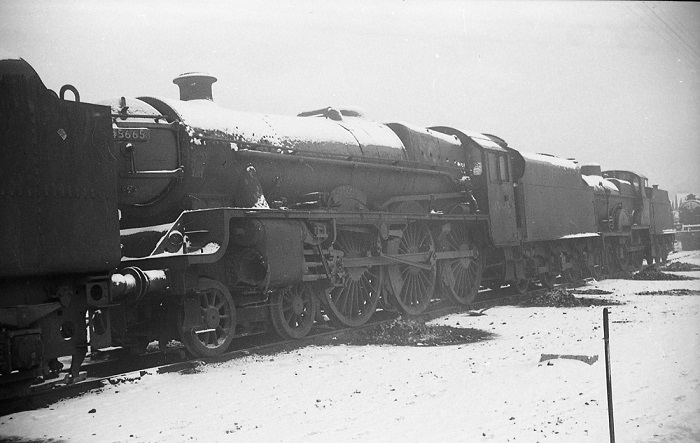
![]()
1962
The snow from December 1961 continued on into 1962 remaining in considerable quantities across the country, on January 2nd the 12.15pm Perth - Euston arrived four hours late at Watford behind D210 & 42960. On the ECML heavy snow fell creating many delays & cancellations. The Home Counties also were affected by snow.

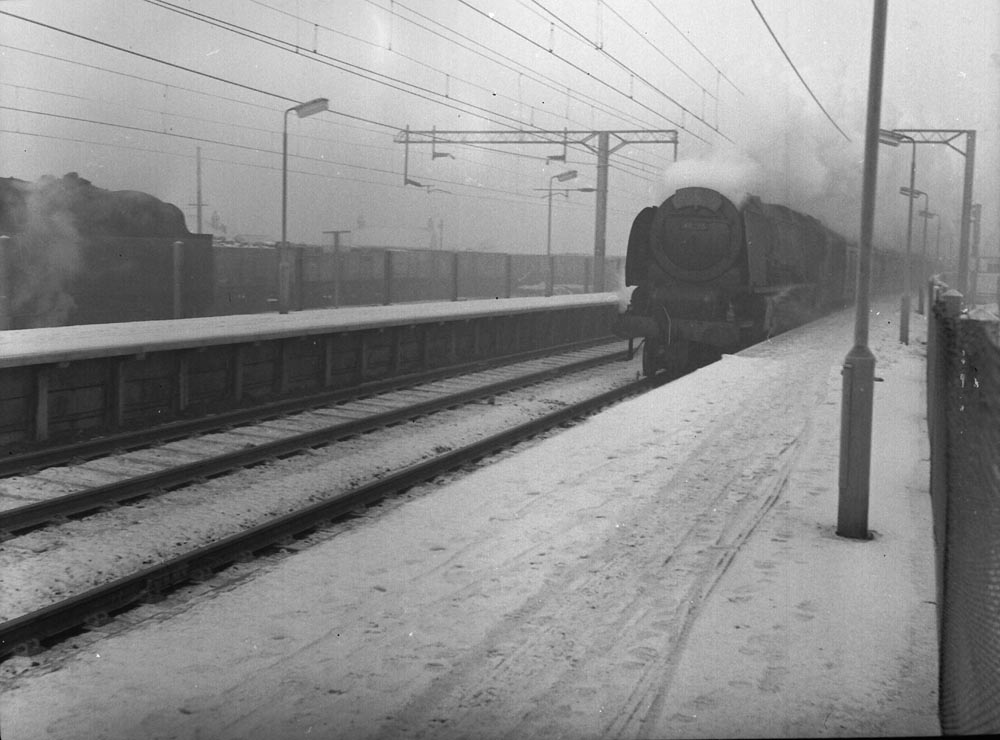
On January 17th gale force winds damaged the overhead wires at Drumry & Bowling on the Glasgow 'Blue Train' electric services.
On February 11th the Dumbarton - Helensburgh service was suspended due to a severe storm. On February 15th/16th severe gales caused damage to the overhead wires in three places on the Manchester - Crewe line.

As a precursor of the winter to come heavy snow fell in mid November causing major delays to the Scottish expresses. The first week of December brought heavy fog to many parts of the country, the smog effect in London killed several hundred people. The lengthened journey times led to difficulties in rostering men and machines, on the Midland the DMU suburban service being hit particularly hard with steam substituting for the struggling railcars. On the first Monday in December a broken down freight near Ampthill delayed the 6.25 Bedford - St Pancras, the following 7.25 cleared many waiting passengers but had an engine seize south of Harpenden, creating huge amounts of smoke. The many hundreds of commuters walked back to Harpenden and were picked up by the up Edinburgh sleeper. On December 4th & 5th the availability of the DMU's was so poor that Stanier Class 5's and Type 2's from the Moorgate services had to fill in on the Bedford/Luton locals. The position was not made any easier by the failure of road/air transport during this time, leading to increased traffic for the railways. A backlog of freights on the Midland mainlne saw much Sunday working, on December 16th eighteen additional freights ran, although one lost its Peak at Elstree to assist 70050 on the down 'Thames-Clyde', after which a vigorous pace was maintained. In the midst of all of this D5084 trialled on the Bedford - Hitchin freight service, apparently none too successful, although this working quite frequently loaded to over fifty wagons of coal and brick. Bedford shed therefore held onto a number of its serviceable 3F's until better replacements could be found.
On the WCML the overnight trains of December 5th were upto seven hours late passing Carlisle from the south due to a derailment at Watford and exceptionally thick fog. Typical was the 9.45pm Euston - Glasgow sleeper, booked arrival time was 6.30am, it did not arrive until 1.37pm behind D122!
Things were little better on the Great Northern line out of Kings Cross, diesel failures required juggling of scarce resources. On December 3rd D385 failed on the 2.05 Kings Cross - York/Hull, rescued by V2 60817 at Tallington, the V2 later took over the 5.15 Colchester - Glasgow, from Peterborough after D246 froze up on shed. The next day D353 failed at Westwood on the 10.25pm ex Newcastle, rescued by 90073. Peterborough also saw the failure of D286 on the 10.20am Kings Cross - Leeds, replaced by V2 60854. None of this was helped by the derailment of coaching stock at New Barnet! On the WCML certain long distance services, especially the overnight sleepers were running from four to eight hours late.
The week up to Christmas had been sunny but frosty, Snow did fall in some places, Glasgow had a white Christmas, with 2-4in falling in the north. however it was on Boxing Day that the 'Great Freeze' set in, with heavy snow accumulations beginning, upto 18 inches falling in the south, particularly south of the Thames. It was possible that the severe cold weather of December 26th may have in some way have contributed to eighteen deaths and thirty three injuries following a collision between Winsford station and Coppenhall Junction. The collision took place shortly after 6pm when the stationary eight coach 4.45pm Liverpool - Birmingham was hit from the rear by the thirteen coach Glasgow - Euston Mid-Day Scot. The two rear coaches of the Birmingham train telescoped during the impact, estimated at a speed of at least 20mph. Responsibility for the collision lay with the driver of the Mid-Day Scot for failing to obey the rules controlling the passing of a signal at red. The trackside phones on the upside were not working, hence the driver's action to proceed to the next signal to seek help, but in doing so misjudged the speed of his train and was unable to stop when the Birmingham train was sighted.
On December 28th & 29th came a major storm with heavy snowfall, for those venturing out to witness the last services from Brecon on December 29th the weather was quite a challenge, but the last day's services did get through, unlike much of the other forms of transport in the area.

The four views below have been graciously provided by Alistair Barrie, using a 7/6d Woolworths camera, which explains the quality of the views, but nevertheless they provide interesting insights into the Scottish winters in this area.
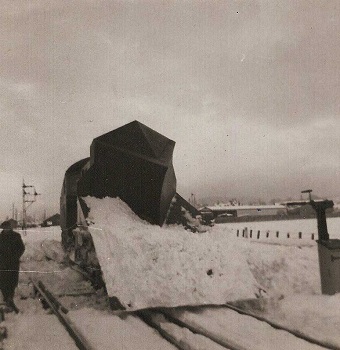
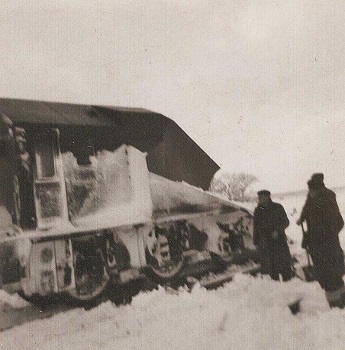
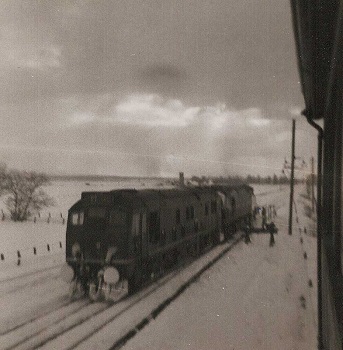

The four black and white photographs show Independent Snow Plough Number 1 being propelled by a Birmingham (BRC&W Type 2 / Class 26) and a Derby (BR Type 2 / Class 24) at Forres West Signal Box possibly early 1961 or 1962 (I cannot remember, although I remember taking the photographs). The extreme right view shows a Hiker (Stanier Black 5) arriving from Keith at Forres with a medium drift plough. Hiker was the normal term for the Stanier Black 5 at Inverness, Aviemore and north of Inverness. The Fairbairn 2-6-4 tanks at Aviemore were known locally as Hiker Pugs.
The end of December 1962 also coincided with a number of branch closures to passenger trains. Scheduled for last passenger services on December 29th was the ex GWR Plymouth - Tavistock - Launceston route, a route which bordered the western edge of Dartmoor. On the 29th easterly winds were blowing, snow had been falling throughout the day, with conditions deteriorating. The 12.40 Launceston - Plymouth with Prairie tank No.5564 and the 4.30pm Tavistock South - Plymouth with Pannier tank 6430 completed their journeys despite the blizzard strengthening and temperatures dropping below freezing. At some point the authorities cancelled the two final services, the 8.40pm Plymouth - Launceston and the 8.35 Launceston - Plymouth, thus leaving two early evening services, the 6.20 Plymouth - Launceston with 5568 & four coaches and the 7.10pm Tavistock - Plymouth to carry the 'last train' titles. The very late running 5.40pm Launceston - Plymouth seriously delayed the northbound 6.20pm service, with the 5.40 pm service eventually reaching Plymouth at 10.25pm.
The northbound 6.20pm and southbound 7.10pm services crossed at Bickleigh. Unfortunately the southbound service, with Pannier tank 6400 had waited so long that it had frozen to the rails. The train crew and three passengers spent the night in the signalbox. The northbound 6.20pm reached Tavistock South at 12.25am (12/30) and was terminated. With the telephone wires down to Lydford, a pilotman was required and he was stuck on the 7.10 Waterloo - Plymouth at Okehampton.
The next day, December 30th, Laira sent out Pannier tank 6430 with a recovery train. It took three hours to reach Bickleigh where 6400 and its train were finally freed and towed to Plymouth, technically completing their service 20 hours late. For the situation at Tavistock Plymouth sent out 34063 and three coaches, which were heavily delayed due to snow on the approaches to Tavistock North. After two hours of snow clearance by railway workers and remaining passengers from the terminated 6.20pm service the train reached Tavistock North, where the locomotive ran round its train and returned via Launceston to Plymouth with its passengers. On December 31st the weather eased a little, Laira sent out a relief to Tavistock to bring in what had been the 6.20pm Plymouth - Launceston behind 5568 - definately the last train.
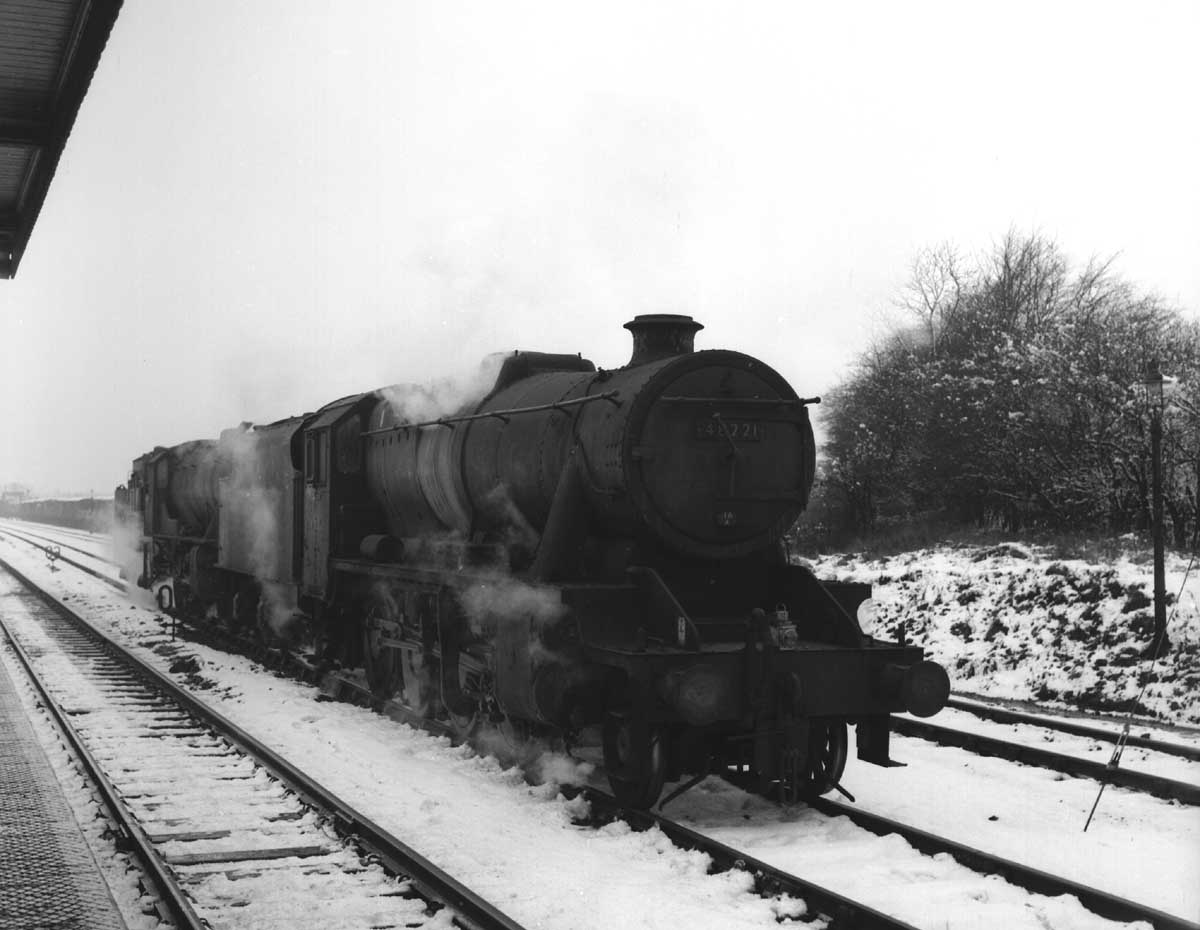
![]()
1963

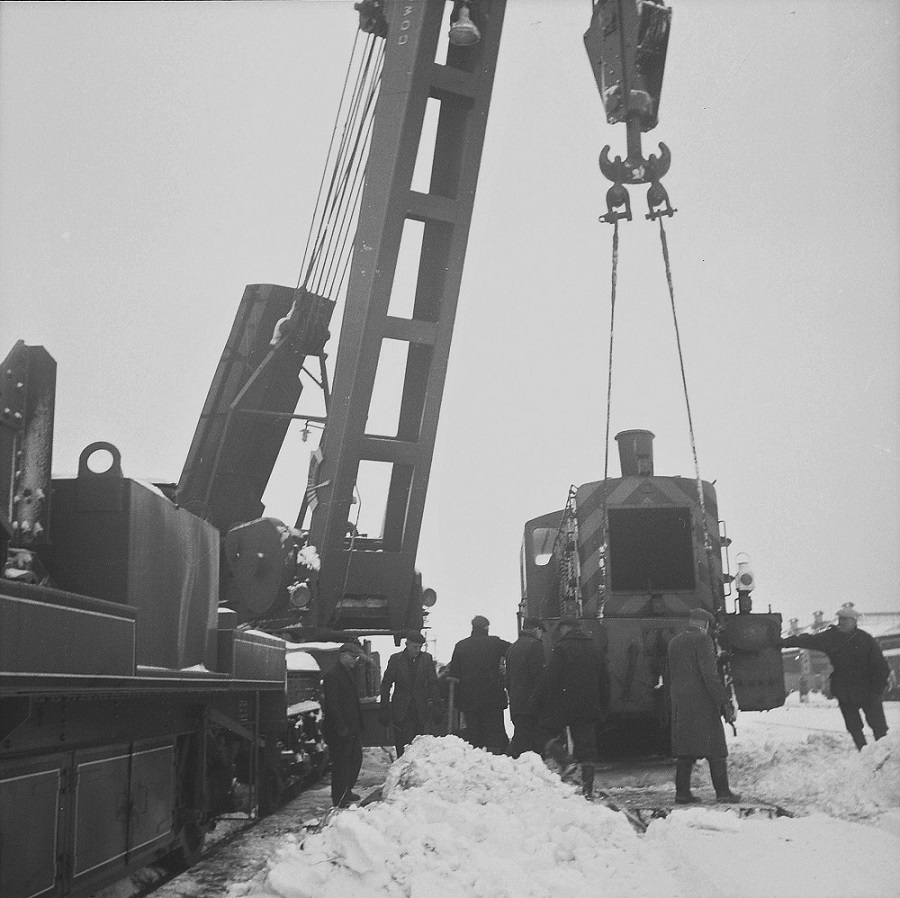
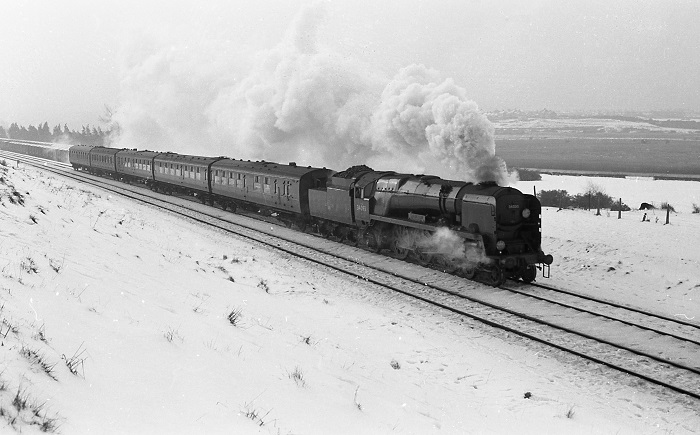
The severe weather of December 1962 grew worse as the New Year began with heavy snow on January 3/4th with a particularly nasty blizzard in the north. On the Waverley route two freights became snowbound at Steele Road & Whitrope summit, with avalanches on January 6th blocking the line between Riccarton and the summit, the line not being cleared until 9th. One of the trapped trains was led by A2 60535 'Hornet's Beauty', single line working was established on the 10th, with the snowplough duty in the hands of 4F 44081, 5MT 45103 & 4MT 43138, working from Riccarton. Trains between London and Glasgow were doing well to be only 4 - 5 hours late. In the south heavy snow and freezing conditions with heavy icing, coupled with power outages played havoc with SR Electric services, these being at an absolute low on January 3rd. So bad was the snow that the Tattenham Corner service resorted to steam haulage, the 'Night Ferry' workings were taken over by double headed BRCW Type 3's, with the diesels assisting other electric services sporadically throughout the region. Heavy snow in the West Country impacted the longer distance SR steam hauled services with drifts up to 15 feet in places. 0-6-0's 30689/97 on snowplough duty over the SR Exeter - Plymouth line spent several days stuck in a drift near Okehampton along with 2-6-0 31838. The snow in the Mendips was considerable, the Somerset & Dorset route looking like a miniature Switzerland. Jinty 3F No.47557 required rescue from heavy snow somewhere on the S&D whilst an undated view at Combe Down Tunnel shows Standard 4MT No. 75071 with a southbound service encoutering snow at least two inches above the railhead. On the Clacton line the new electric service commenced apparently without too many problems. The DMU service out of St Pancras did not fair well, being assisted by scratch coaching sets hauled by whatever serviceable steam & diesel locomotives were available. As elsewhere a shortage of coal only exacerbated the situation. In the midst of these woes a series of fires on the Calder Valley BRCW diesel multiple units, culminated on January 13th with a fire on the 07:31 York - Liverpool at Sowerby Bridge. This led to the withdrawal of these multiple units whilst the origin of the fires was determined, causing a major shortage at Neville Hill depot. DMU's were borrowed from Darlington & Newcastle but steam was still substituted on many Bradford area services. On the WR the closure of the Banbury - Princes Risborough line due to snow led to the Paddington - Birmingham/Wolverhampton services being diverted via Reading & Oxford for a considerable part of January.
It is reported that on January 12th the only water available between Euston & Rugby was that at Tring, elsewhere the water was frozen.

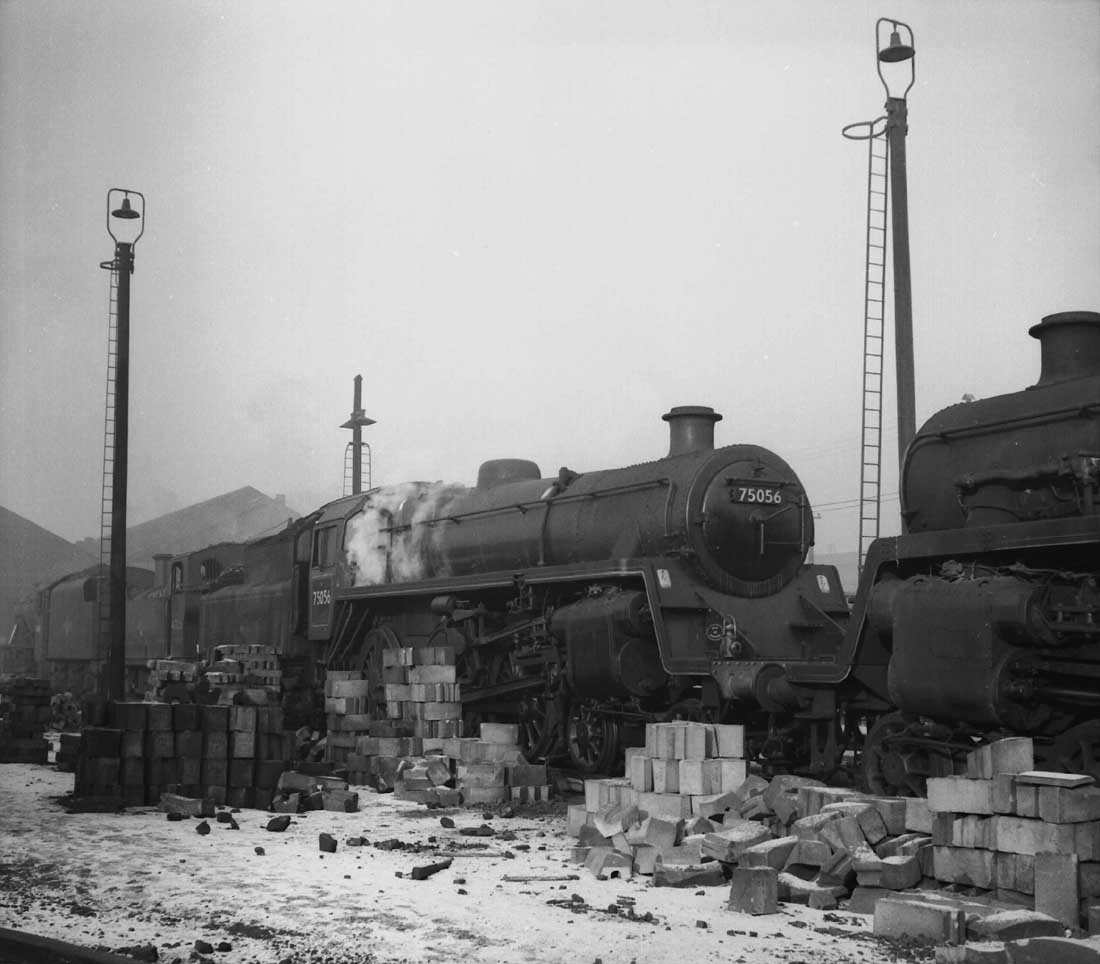
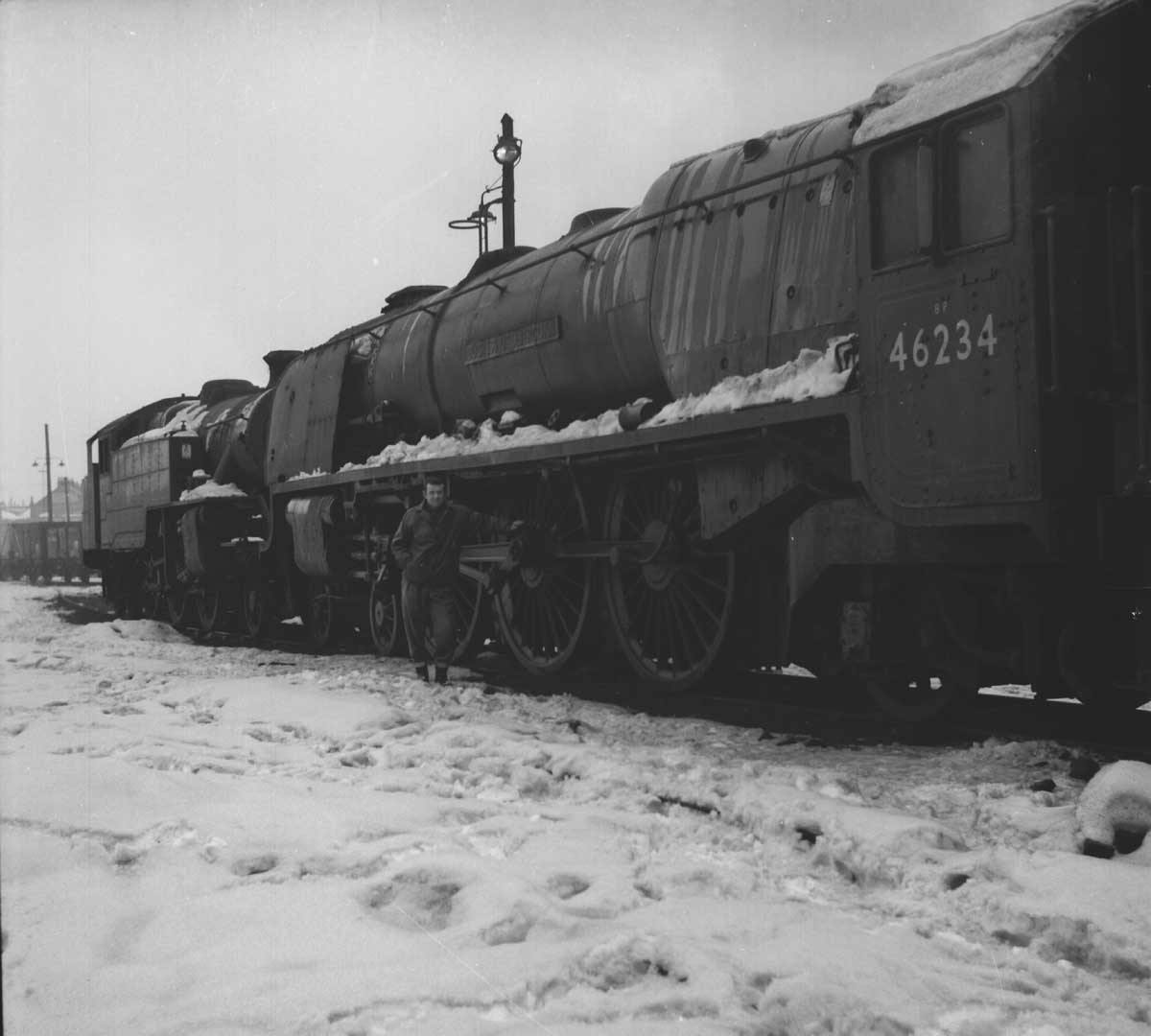
Severe weather resumed on January 18th plunging many parts of the country into a further week of struggles. Blizzards on the night of 19th blocked the Calder Valley mainline for twelve hours, many local services were steam hauled. The Rochdale - Oldham line became impassable with drifts, an attempt on the 20th led to the multiple unit becoming stuck for two days! Single line working had been established on 21st but a derailment at Royton Jct put paid to any further service for a while. In Derbyshire on January 21st snow ploughs spent a day clearing the Buxton - Ashbourne line, returning with grocery provisions for the besieged village of Hartington. Also sent out to here, at the request of the police was one passenger coach coupled to 42799 & 44868 to rescue a party stranded at the village. The rescue attempt itself became stuck near Hindlow, as did 8F 48062 sent to assist. Rescue finally came in the shape of the three original engines and ploughs returning from Ashbourne, the party finally reaching Buxton late that night. The next night the 10:05pm Edinburgh Waverley - St Pancras became stuck in heavy drifts near Dent, the rear coaches were able to return to Carlisle reaching London via Newcastle. The line through Dent would not re-open until January 24th. The severe weather reached the East Coast, with heavy freezing, causing adhesion problems for the diesel multiple units working the steeply graded lines of the East Riding of Yorkshire. Further south the GE line Type 4's from Stratford were not doing well with a number of Type 2's substituting. So noted during this period was D5044 on the 12.40 Harwich - Rugby and D5018 on the 5.15 Colchester - Glasgow, both diesels being replaced at Peterborough. At the southern end of the GN mainline the shortages were not helped by the untimely storage of the 'Baby Deltic' fleet at Stratford, with engine problems. A bizarre consequence of this weather was the formation of giant icicles in many tunnels. Both Ampthill and Kilsby tunnels suffered this phenomena, line closures being necessary to clear them, especially after those at Kilsby had caused injuries to a number of footplate crews. Torpantau tunnel on the Merthyr - Brecon line was found to have huge amounts of snow and ice overhanging the northern portal, the daily goods was suspended until local railway staff had spent a day making the tunnel entrance safe. Milder temperatures set in after 26th.
Availability of the Peaks on the NE/SW services fell from 80% to 50% with some interesting steam substitutions. Barrow Road had few steam engines (three Jubilees & six BR Class 5's) to spare so anything that could be found as serviceable was put into service, particularly incoming locomotives from the north - Carlisle's 46128 was Barrow Road's diesel standby on January 13/14th. The 6.46am Gloucester - Sheffield had Grange 6868 to Birmingham New Street on January 17th, the day before Annesley based 46126 worked throughout, by 22nd Canklow's B1 61033 was in charge. January 10th's 7.35am Bristol - Bradford had Pannier Tank 9453 leading a B1 one hundred & fifty minutes late into New Street, a Class 5 4-6-0 was waiting to take the service north, but was not needed when the service was terminated. From the north came a variety of V2's, A3 60039 on January 24th's 8.20am Newcastle - Swansea almost made it to New Street, only to expire at Kingsbury, before retiring to Saltley and being noted in the Derby area for several days. The Pines Express was cancelled from January 2nd - 5th.
(Below) Information on this view is not known but the location is believed to be Tillynaught on the Aberdeen - Inverness GNSR route.
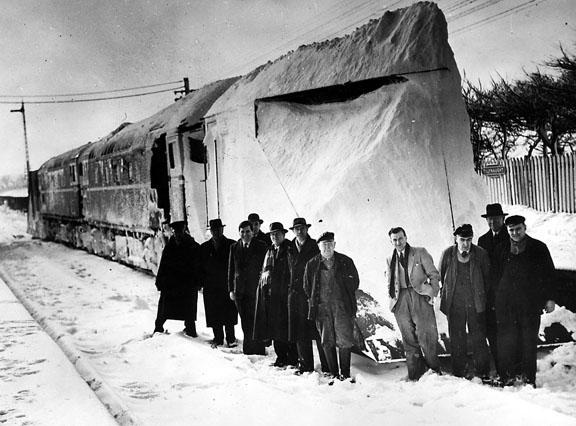
More heavy snow fell on February 5th & 6th, four - five foot drifts occurred in parts of Wales.. The Settle & Carlisle line became blocked between Mallerstang & Dent, not being re-opened until February 23rd. Although the line was clear of snow only freights were initially allowed to use the line, avalanches were still considered a hazard, passenger services continued to be routed over the Clapham branch to Tebay. Also blocked were the routes south of Carlisle and two of the three routes to the north, which led to the long distance WCML services being routed through Newcastle on February 6th. This led to the unusual event of adjacent platforms at Newcastle hosting the down 'Flying Scotsman' and the up 'Royal Scot'. Also travelling this route was the up 'Thames-Clyde Express' behind D162, running late due to snowdrifts on the ECML at Stannington. Following minutes behind was the up 'Royal Scot' hauled by D300. Further west the 05:10 Glasgow - Stranraer passenger service became trapped in heavy drifts (up to 30 feet) at Barrhill. A number of passengers were rescued by helicopter, others by a rescue service sent out from Girvan. The line would re-open on 10th only to succumb on 13th & 14th to more blizzards. Ayr - Stranraer service were re-established via Dumfries, the direct route not being available for another week. On the West Highland two snow clearing diesels became derailed by hard packed snow near Bridge of Orchy. The continued heavy frosts led to the imposition of a 60mph speed restriction throughout Scotland during February. In the West Country five trains became trapped in Devon as the blizzard of February 5th moved south. Hardest hit were the former SR branches, the Plymouth - Brighton through services being sent over the WR mainline between Plymouth & Exeter for awhile. Okehampton at one point was completely cut off from the rail network. The disruption to freight traffic in the London area saw many unusual visitors to the SR on a variety of cross London freights, with a number of Willesden's Type 2's reaching Redhill and Three Bridges.
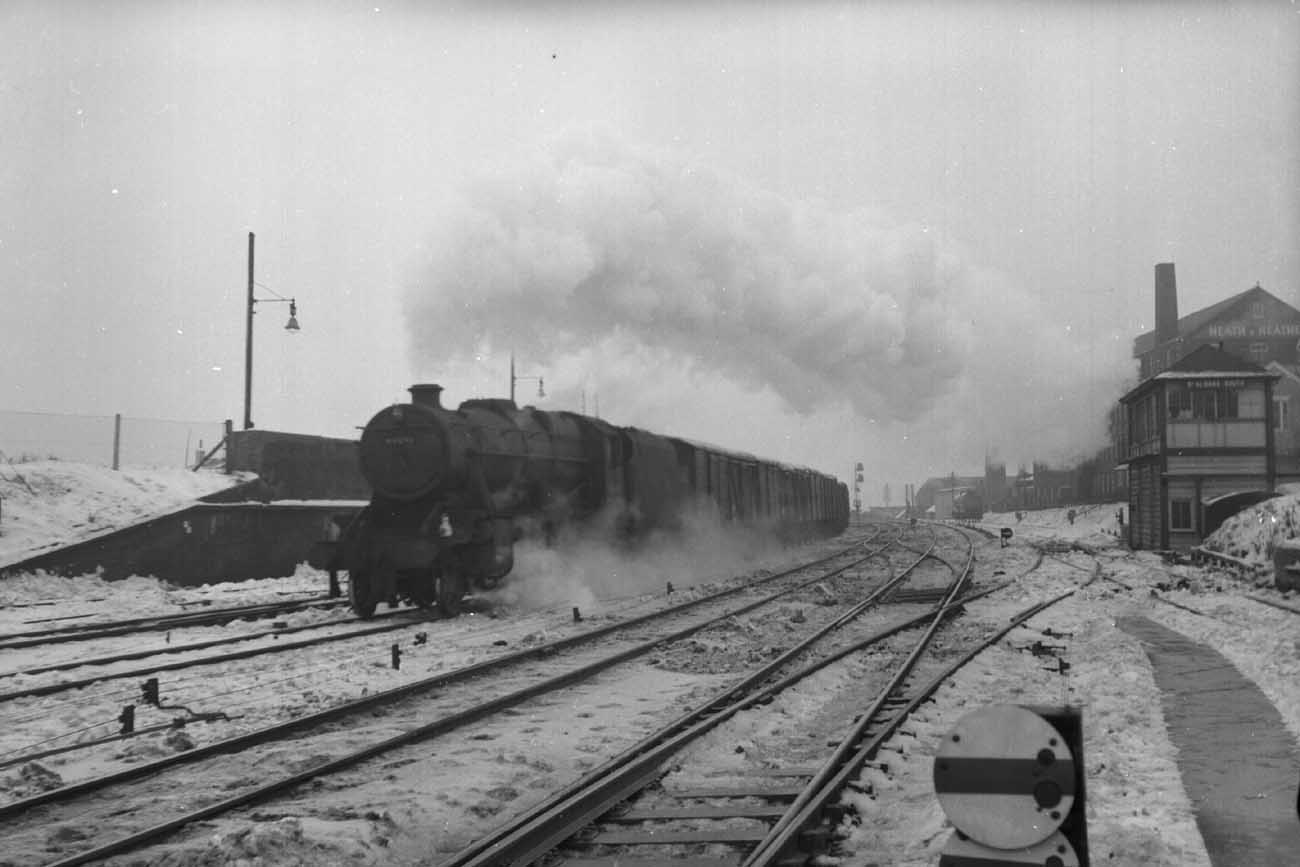
On February 9th two days of heavy snowfall blocked the Aviemore - Forres line in the area of Dava Moor. Despite the presence of snowfences about one and a half miles of line was blocked, with drifts to thirty feet. Several snowploughs were sent out to clear the line but these became derailed. One such train was powered by a Class 26 & 24, the plough ended up on its side, the Class 26 was completely derailed and sustained minor damage. Eventually forty nine men were used to clear the line, taking 21 days and a quantity of dynamite.




The impact of this prolonged severe weather on the diesel fleet was catastrophic. For those diesels that escaped freeze damage to the power unit/cooling system they were generally relegated to freight diagrams following the failure of their steam heating boilers. In their place ran many of the steam locomotives that had only recently been taken out of service, many of them in a very run-down condition, typical of this was the re-activation of a number of rundown Jubilees from Burton shed to cover shortages on the Midland main line. The disruption was made worse by the length of the severe weather and the closure of lines simply due to the volume of snow. The Class 24's covering the Tring/Bletchley/Northampton services suffered to the extent that less than a handful were available, resulting in a steam revival on these lines. On the lines out of St Pancras availability of the Peaks fell to about 50% caused by frost damage, mechanical failures and boiler failures. The DMU's also suffered failures in service as the air control lines froze up. And steam was not immune from the problems, water and coal supplies froze, the latter also being in short supply in some areas. And into this chaos of fog, snow and ice came the first of the Class 25/1's, D5176 from Darlington during the middle of January.
A visit to North Eastern area sheds on a dull and overcast February 17th found several inches of snow on the ground at Darlington, Tyne Dock, North Blythe and Blaydon. In many cases the depots contained withdrawn steam locomotive, most of which would not see another winter season.

March 5th saw the first frost free night in Britain since December 22nd and would signal the start of a gradual thaw that would end this memorable cold spell. However in many parts of the country snow would remain late into April.
Extremely cold weather in the north east in late December caused a number of diesel failures. To cover the shortages five 9F's were loaned to Heaton from Tyne Dock for two weeks. They were primarily used on goods trains to Tees Yard & York. However on December 21st 92061 reached Millerhill on a special freight from Heaton. And on Christmas Eve 92097 handled empty stock workings between Heaton & Newcastle!
![]()
1964
On January 12th there was light snowfall in Eastern England, with a heavier snowfall in the south. The next day (13th) the snow and cold weather challenged the Southern Region electric services with many cancellations & delays. The disruption saw BR Standard 4MT No. 80085 with two coaches provide an impromptu morning service between Tonbridge & Ashford.
There was snow in the Derby area on February 18th, it may have been responsible for the derailment of Jubilee 45579 Punjab at Denby Colliery trap points. The Derby 4 shed breakdown train with 8F 48183 was sent up to rerail the errant locomotive, all the tender wheels were derailed, with the tender leaning over, whilst the locomotive had one pair of wheels on the ground. It continued to snow during the rerailing with the crane required to lift the tender. After examination at Derby 45579 was pronounced OK for further use. (M Peakman)
Heavy rain on March 14th/15th caused several landslips, including a serious slip between East Grinstead & Forest Row, which closed the line for a week.
On the night of May 30th/31st heavy rains flooded the Diggle route, with fifteen trains diverted over the Calder Valley route. A Hull - Liverpool diesel multiple unit became stuck in Diggle Tunnel for four hours, rescue coming in the shape of a train drawn alongside to transfer the passengers. Normal service over the Diggle route was resumed within 24 hours.
The evening of July 21st produced storms over south London with flooding affecting the Epsom Downs branch and Sutton station. At least four services between Wallington & Epsom Downs resorted to BRCW Type 3 haulage.
Severe storms in the north of England produced winds strong enough to blow Vauxhall cars off a northbound car carrier that was crossing Ribblehead viaduct on December 8th??
On December 14th flooding closed the line between Aberyswyth & Strata Florida.
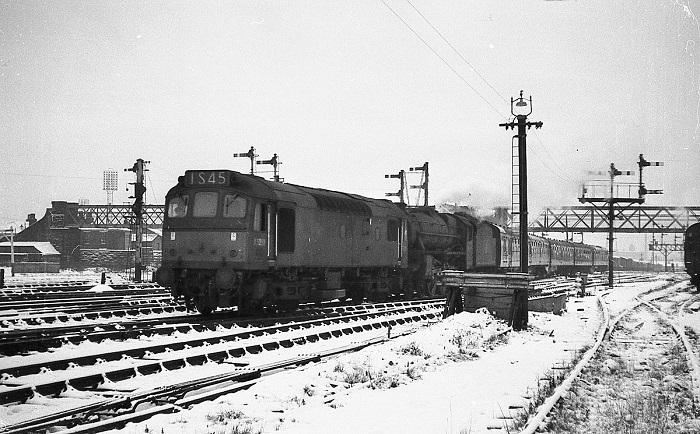
There was several inches of snow in the West Country on December 27th/28th.
On December 31st passengers intending to travel on the Bala - Llangollen line were put on buses due to severe flooding.
![]()
1965
On March 3rd heavy snows in south-west Scotland saw many services revert to steam haulage especially those operating around Ayr. Black Fives 45486 & 45029 were equipped with large ploughs to clear affected lines, whilst some Crabs received buffer beam mounted snowploughs to deal with lesser drifts. In the North-East the beginning of March saw severe weather with much snow led to many mainline passenger services being hauled by steam. Heavy snows in the Stafford area on March 3rd required snowploughs to clear the WCML. Heavy snowfalls continued into March 4th with long distance expresses into St Pancras heavily delayed. At Woking the heavy snowfall was compounded by a failure of the power signalling, causing heavy delays to many services.
Blizzards were noted in Yorkshire on March 20th.
Easter was accompanied by snow showers on 18th.
July proved to be a wet month in many areas. Flooding at Standedge on July 13th resulted in the diversion via Hebden Bridge of several trains. During the afternoon of July 20th heavy rain seriously impacted services out of Kings Cross. The flooding of the Gasworks tunnels saw services turned round at Finsbury Park, with passenger using the tube to reach Kings Cross, though the tube's Kings Cross booking office did sustain flooding. By late afternoon flooding had subsided enough to allow services to resume.
The first heavy fog of the season occurred on October 22nd in London and the Home Counties. Services out of Waterloo were heavily impacted due to the fast lines not being available between Farnborough & Winchfield.
Heavy snow fell in November, in parts of Lincolnshire it lay on the ground for at least ten days.
On November 27th the first snow of the winter, several inches at least, fell over the southern Peak District and the north Yorkshire moors.
![]()
1966
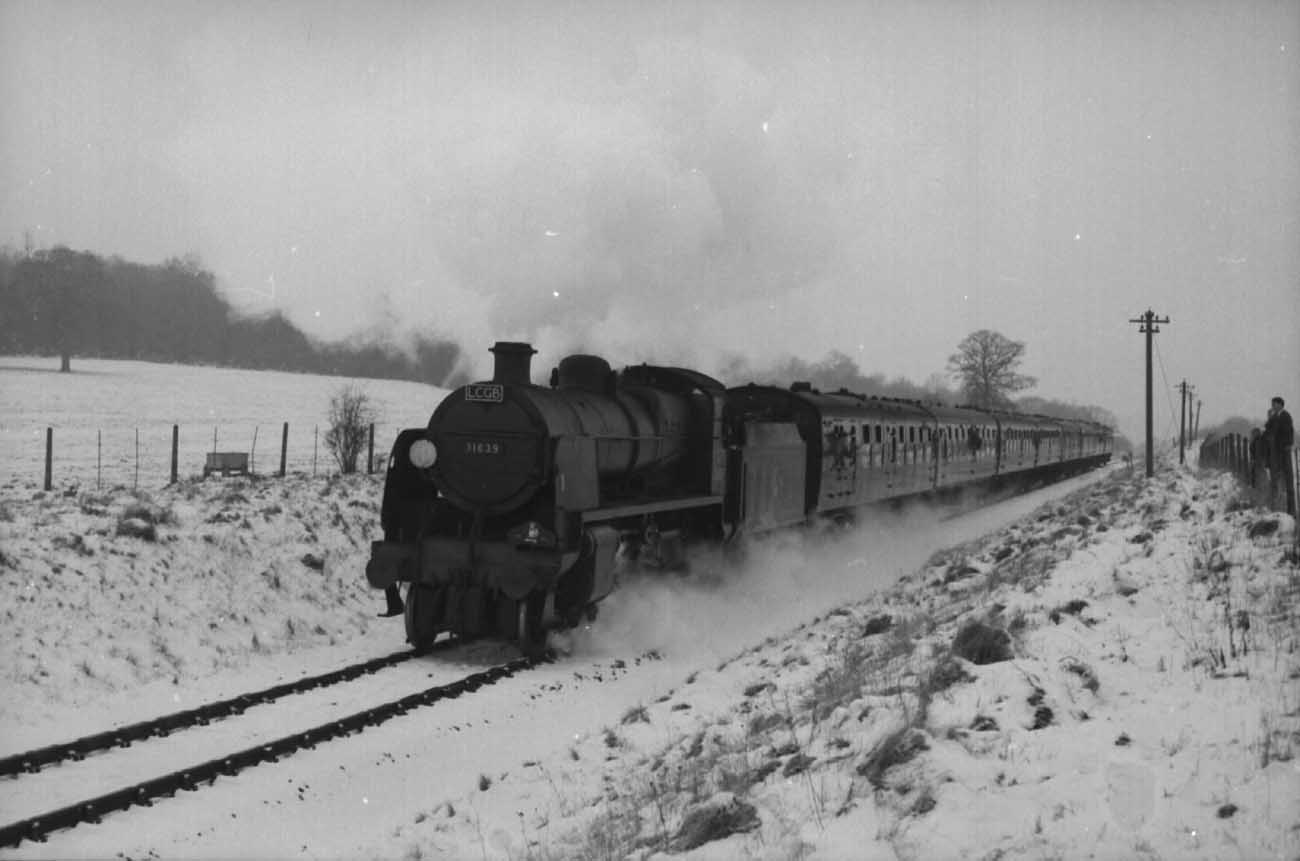
Wintry conditions affected parts of the country between January 15th & 20th with snow in many areas. Blizzards on the 17th & 20th affected Kent with the Night Ferry reverting to two Type 3 diesels instead of the more normal electric locomotive. A de-icing train also traversed the North Kent line between Ramsgate, Faversham & Dover. Freezing rain on the morning of the 20th seriously impacted many Southern electric services. For most of the day the services operating bore little resemblance to the timetable, with steam and diesel assistance provided on some routes.
On February 10th at Flitwick twelve loaded wagons hauled by D5218 ran into a stationary ?? immediately north of the station. Most of the train was derailed, necessitating the attendance of D7503 and the Cricklewood crane. The lines was cleared by midnight, hindered additionally by a snowfall. The damaged locomotives were removed to Bedford, prior to heading north to Derby Works.
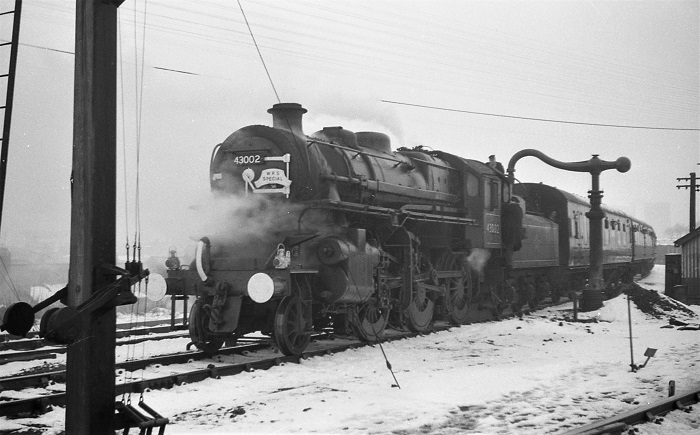
About a week later on February 19th heavy snow in the Glasgow area affected traffic. In particular disruption to the Gourock & Wemyss Bay lines gave passengers a very challenging time. Many ended up having their journey utilise steam traction, a bus, a diesel multiple unit and more steam traction. A landslip near Dunrod signalbox just made everything more complicated. The snow brought down the wires at Georgetown during the morning, buses filled in until the wires were repaired later that day.
A moderate fall of snow occurred on the west side of the Pennines during the first week of April. On April 2nd Class 4 4-6-0 Nos. 75012 & 75015 were on snowplough duty between Skipton & Garsdale. Also on this date passengers on the SLS Lakes & Fells Railtour hauled by 46458 & 46426 enjoyed snow covered countryside and Lakeland Fells as they journeyed between Keswick & Penrith. The exit to Accrington diesel multiple unit depot became blocked by snow leading to some service interruptions. The Penistone branch needed snow removal, with 48340 & 48206 running tender to tender. In the Kent area Faversham depot sent out a de-icing unit during daylight hours on April 2nd.
There was a good snowfall in the Glasgow area during November.
The recently installed signalling system between Didcot & Swindon suffered problems on the morning of December 3rd due to a severe frost. Delays were incurred by several passenger services.
Heavy rain on December 10th in the south of England led to a brief closure of the Dover - Folkestone line due to chalk rockfalls. Two days later during the evening (12th) more significant rockfalls near Shakespeare tunnel closed the line for two days after a Charing Cross - Ramsgate electric service ran into the rockfall, derailing and damaging the unit.
![]()
1967
The end of February saw gale force winds damage telephone wires and poles between Nethercleugh & Kilpatrick on the WCML.
The first week of May saw snow over the northern Pennines, creating operating challenges for the higher elevations on the Settle & Carlisle route.
On June 1st a thunderstorm in the Bradford area caused flooding and damaged an embankment near New Pudsey, leading to considerable disruption of services. Severe thunderstorms on the afternoon of June 25th in the London area saw lightning hit the overhead electrical equipment near Southend, causing delays of up to two hours for the suburban passenger services.
During the night of October 16th/17th severe gales in the south of England blew down many trees, the South-West Division was most affected, with services disrupted well into the morning and early afternoon of October 17th.
Heavy snow fell in the west of England and parts of the south on December 8th & 9th. The snow on the 8th delayed west of England expresses whilst the snowfall on December 9th caused serious operating problems in south Devon. Some local services were cancelled in the Exeter area, with mainline services making extra stops, though these services were delays between sixty and two hundred minutes. On the Southern Region's Western Division one day ASLEF 'work-to-rule' strikes on December 4th & 6th were then followed by miserable weather conditions on 8th & 9th. The snow and ice particulary affected the shoegear on the REP & VEP units, with services on the Waterloo - Bournemouth line being quite a shambles. The snow on December 9th caused major operating difficulties to the Exeter - Waterloo services. Although the snow would quickly disappear, an emergency service operated until December 11th due to damaged electric stock. The Central Division was also heavily impacted, no train movements were recorded at Brighton for a period of four hours on December 8th. Many services were cancelled, those that did run often bore little resemblance to the timetable working, with many being diverted. On the electrified Hastings - Eastbourne route, two diesel unit sets formed the services. Services disruptions continued until December 11th.
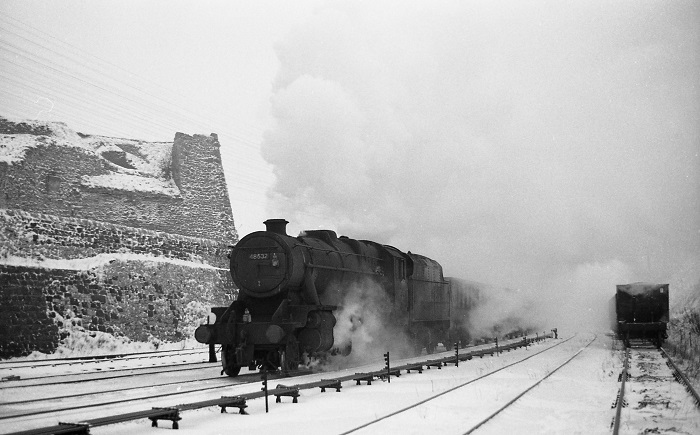
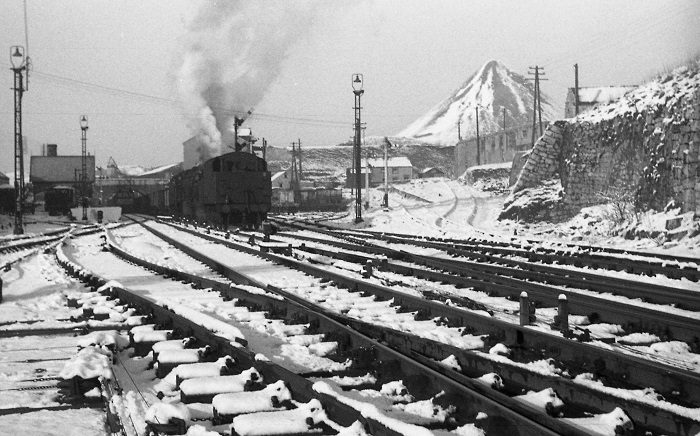
![]()
1968
Although this January was a remarkably mild one heavy snowstorms on January 9th & 10th brought considerable chaos to many parts of the country. Particularly hard hit were the London commuters with most of the termini suffering many cancellations due to frozen up equipment. Perhaps because of this it was no surprise to find Holbeck based D5112 at St Pancras on 9th, whilst on 13th D7573 was noted southbound through Newark with the 08.25 Leeds - Kings Cross, albeit with four coaches only! And passengers on rush hour services into Liverpool St were taking an hour to cover the final four miles into the terminus. But as the morning progressed timekeeping began to improve.
Birmingham New Street came to a complete standstill between 6am & 9am with the heavy snowfall and freezing conditions causing many point failures. Numerous local services were cancelled, many used Moor Street as did the Paddington services. Tyseley improvised quickly with the fitting of old steam lances to boiler equipped diesels for the purposes of clearing ice and snow from pointwork. Tyseley adapted these lances for at least three Type 2s and later to some Brush Type 4s. Additionally services out of Paddington were still trying to recover from a freight train derailment at Southall on the afternoon of the 8th, which had left only the up relief line open.
In the West Country heavy flooding closed Exeter St David's station with water as high as the platforms, the Barnstaple - Exeter line was closed for several days due to subsidence problems, trapping the local freight. Also lost to floodwaters was the A39 Bideford Road bridge across the river Torridge. To alleviate this the Bideford - Torrington line was re-opened (previously closed October 1965), using a single car diesel multiple unit working a shuttle service on the east side of the river to Torrington, from there a bus service shuttled passengers to Bideford.
At Waterloo the rush hour was badly impacted due to congestion, possibly the late arrivals of mail and milk trains took away some of the needed platforms. On the South Eastern Division timekeeping was seriously impacted on trains from London to Dover & Folkestone.
A major storm caused major problems in the Clyde valley on January 14/15th. Severe interruptions occurred to Glasgow area services, the 15th saw most of the Blue Train services stopped, services to Ayrshire and the north were also greatly affected.
There was considerable snow along the Pennines and in the Peak District during the first week of February, particularly in the Buxton area. On the 6th the heavy snow disrupted trains around Hazel Grove, leading to many delays and cancellations. There was heavy snow in Lancashire on February 5th, a Preston - Liverpool service with 44942 ran through the closed level crossing gates at Rufford, its not recorded if the heavy snow was in any way responsible. An early morning Manchester Exchange - Leeds three car multiple unit on February 7th was well filled due to the snow halting other forms of transport.
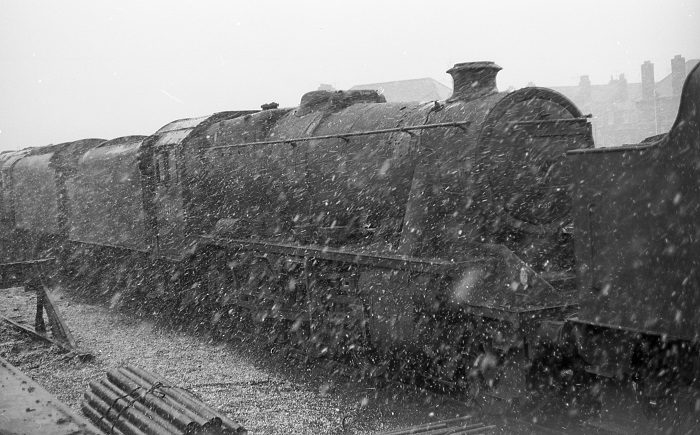
A localised major storm on February 5th brought cold and snowy weather to the West Midland, 37cm of snow fell at Keele whilst Crewe & Birmingham suffered major traffic disruptions, but only forty miles away at Nottingham there was only rain. Snow did eventually reach Central Eastern England and remained at least until February 8th.

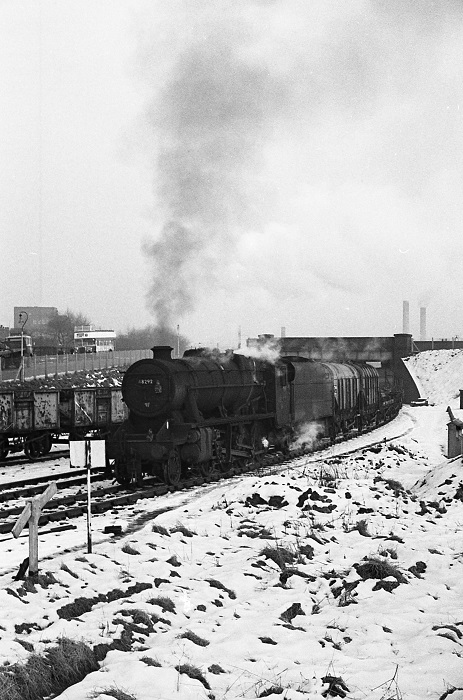
During April there was widespread light snow & a blizzard in Scotland on 2nd.
Snow fell in the Midlands on May 18th.
Heavy rain on July 9th & 10th caused all sorts of problems for the railways. The Salisbury - Exeter line was closed near Honiton tunnel. The mainline south-west of Bristol was closed at Flax Bourton due to extensive landslips at the east end of the tunnel and some bridge problems. London trains were diverted via Westbury whilst NE/SW trains were diverted Bath & Westbury. Many trains were reported two to three hours late, assuming they hadn't been cancelled or terminated. In the Bristol area on the evening of July 10th the rain caused flooding which isolated the station. Empty coaches were brought into the station to provide overnight accommodation for stranded passengers. As well as at Flax Bourton, serious blockages also occurred at Patchway Tunnel, Wickwar & Chipping Sodbury. On July 13th a temporary shuttle, using one line, was established between Taunton & Bristol. The mainline diversions via Bath & Westbury continued until July 15th. The heavy rains on the 10th affected many train services in the Worcester area.
On the Southern Region flooding at Fulwell closed the Shepperton branch. A landslip at Sway closed the down line, causing alterations to some services. The weekend of September 14th/15th brought torrential rain to southern England causing rivers to overflow their banks, with consequent disruption to many rail services. On the South West Division bridges were damaged near Cobham station and the viaduct over the River Wey at Godalming. The latter affected the Portsmouth Direct line services, it was not until September 29th that a single line was reopened utilising a temporary bridge. Unfortunately the Mid-Sussex line could not be used as a diversionary route due to flooding near Pulborough and a landslip near Ockley. Naturally rolling stock and traincrew disorganisation further complicated the operation of services.
On the Central Division flooding blocked the Brighton line at Balcombe tunnel, flooding also claimed the Quarry line at Earleswood whilst a landslip near Lingfield closed the East Grinstead line and a landslip near Merstham tunnel caused more disruption. Diversions were enacted but those routed via Three Bridges, Horsham & Dorking were disrupted due to floods near Ashtead. Closer to London flooding caused disruption at Mitcham Junction and also at Denmark Hill, blocking the South London line. Many other lines remained open despite suffering from lesser damages from the storm. Edenbridge Town also suffered flooding, disrupting the Charing Cross - Hastings services. The reduced number of services on the Sunday no doubt helped the authorities in working through all the damaged track and structures at many locations, but it was insufficient time to get the timetable ready for the Monday commuters.
Although some gains were made, other ground was lost, a landslip claimed access to several platforms at East Croydon, the landslips between Dorking & Horsham worsened and further flooding between Pulborough & Amberley caused major diversions for the Victoria - Bognor Regis services. On the Tuesday a landslip closed the Crystal Palace - Beckenham line for ten days. Minor, short term issues continued to manifest themselves, but gradually authorities were able to make good the flooding and landslide damages, such that by the end of September all services had been reinstated, though often with severe speed restrictions affecting timekeeping.
The September 14th/15th storm created problems in East Anglia. The Norwich - Ipswich main line was closed near Burston due to flooding and damage to a bridge, whilst the Cambridge main line was flooded near Broxbourne. Diversionary services worked well, but some were of a lengthy nature, the Norwich - London services being routed via Lowestoft. Services to Southend Victoria were suspended due to flooding near Rochford, a bus service being the replacement between Southend and Rayleigh.
During December there was much snow between Christmas & the New Year, including East Anglia sustaining fog and a heavy snowfall on December 28th/29th/30th, especially affecting the Norwich & Colchester areas. Late on Christmas Eve snow & sleet fell causing major problems on the South Western Division, with no services on Christmas day the ice buildup on the rails created major problems the next day! On Boxing Day severe icing caused Central Division delays of up to three hours to the electric services, with some trains combined to 16 & 18 cars.
![]()
1969
On January 4th the Edinburgh - Carlisle 'Waverley' route was closed. Ironically on this last day 'Grand Tour No. 6' hauled by 1974 with a full complement of passengers traversed the Waverley route en route to Newcastle. From here a trip to Benton & Tynemouth used 250, on return to Newcastle 1974 regained the train for the run back to Edinburgh via the coast route. The last scheduled train, the 1M82 21.55 Edinburgh - St. Pancras, with eight coaches and two sleepers was handled by Class 45, 60. Carlisle was reached over two hours late caused by the boisterous activities of many local people protesting the closure of the route. The Hawick pilot, 8606, was sent ahead light engine to ensure the integrity of the line south of Hawick. A light snow fall had taken place during the day, but the evening saw clearing allowing the sun to set one last time on this run and providing the protesters with a chilly night out.
Further south and also on January 4th, tragedy struck the Southern Region, when in thick fog, an evening Charing Cross - Ramsgate express ran into the rear of a parcels train near Marden. Regrettably the driver of the express and four passengers were killed, with many others needing hospital attention. The units involved were 7181 & 7117, with the two leading coaches from 7181 being severely damaged, many vehicles from the parcels train were broken up at the scene of the accident.
February 7th brought some intense severe weather to most parts of the country. The low level wind speed record for the month was set at Kirkwall on this date with a speed of 118kn. Blizzard conditions in the London area affected many services, Waterloo was badly impacted, as in many places the gas powered point heater pilot lights were blown out by the gale force winds. Many of the Southern Region VEP & REP electric multiple units were taken out of service, their already troublesome lighter weight shoe gear suffered badly from the quantities of snow & ice encountered. In Kent the 21.36 Charing Cross - Ramsgate formed of 4-CEP's 7107 & 7201 became well and truly stuck in a drift between Herne Bay & Reculver. The train had left London two hours late becoming stuck just before 3am. In trying to protect the train the guard had trouble in laying the detonators, the snow was so deep. The darkness and depth of the snow prevented rescue by air or road, the neighbouring A2 had accumulated eight foot drifts. Just after 7am E6036 & D6596 reached the stranded train, pulling it and its three crew and seven passengers back to Herne Bay. The last down train of that night, the 23.10 Victoria - Ramsgate with 4-CEP's 7113/31 arrived at Herne Bay at 09.45, just over nine hours late! It remained there for another half hour until snowploughs powered by 6571/91 had finished clearing the route.
 | From time to time things stick in our memories. In finding this Diesel Multiple Unit ABC in a shoebox recently it brought back a flood of memories about my early gricing days. This was about the time I purchased my first Ian Allan ABC Combine (from 1970 with a Peak & a Brush 4 at Bath Road on the cover) and probably at the same time this 1970 DMU volume, possibly because of the wintry scene on the cover. It would mark a point in time when my interest in the railways became more tangible with the recording of numbers in notebooks, Works & depot visits and the delights of train travel whether it be a day excursion or a scheduled service - the journey had begun. The booklet's cover view, provided by D L Percival, featured the 15.04 Kings Cross - Letchworth at Langley Junction near Stevenage on February 8th 1969. The wintry weather was clearly in evidence on this day. |
The Midlands also bore scars from the blizzards of February 7th. In the Derby area the point heaters were operational, but the point rodding froze up, throwing the evening commuter services into chaos. Restricted access to the station affected many services, with delays up to two hours noted. Manchester was ill prepared for the storm, suffering many cancellations & delays to both local & long distance services. On the Woodhead route the Manchester - Sheffield electric service encountered delays with diesels taking over a number of the services. East of the Pennines delays occurred and services were amended to fill in the gaps. The 21.50 eight coach York - Aberystwyth mail was surprisingly hauled by 5150, filling in between Leeds & Huddersfield as a local. Hopeless road conditions necessitated the rescue of fifty students from Marsden by a two car diesel multiple unit. Heavy snow on February 7th greatly affected the Great Eastern lines, but by the next day delays and interruptions were greatly reduced.
Scotland appeared to miss the worst of this weather though services from the south were often hours late. Such was the 23.35 (Fri) Euston - Glasgow Central which arrived behind 445 at 13.52, almost seven & half hours late. When another storm hit the Manchester area on the 14th the previous lessons had been well learned with an almost normal service operating.
February 14th/15th saw the north-west receive a substantial snowfall but lessons learned from the blizzards of February 7th were put to good use.
February 20th produced even worse weather, with the 7.56 Sheffield Victoria - Manchester stuck in a drift for five hours. A similar situation befell the 18.02 New Mills - Sheffield Midland on the Hope Valley route, this diesel multiple unit becoming stuck at the west end of Cowburn tunnel. The 19.10 Sheffield - New Mills only reached Chinley with the help of two Class 20s taken from Earles Sidings. These locomotives then rescued the passengers from the stranded 18.02, this multiple unit not being dug out until the next afternoon! At Diggle the semaphore signalling froze, with hand signalling resorted to. At the same location the 17.05 ex-Liverpool (Newcastle?) with 174 took three attempts to break through the snow drifts. The diesel multiple unit service on the Penistone branch became superpowered on the 19th when Class 40 No.399 piloted all trains between Clayton West Junction & Penistone due to the appalling conditions. So bad was the weather that 6922 even after splitting the 27 loaded coal wagons was unable to depart Skelmanthorpe for Clayton West. The train was abandoned and 6922 set of for Healey Mills only to become a total failure near Brockholes, eventually being pushed into Huddersfield by two local multiple units. That night the Penistone line was kept clear by two snowploughs handled by Healey Mills Class 37s making four trips over the line.
Coventry was prepared for this blizzard having steam lance equipped 1950 available to free frozen pointwork. It was however not able to handle ice accumulation on the overhead line equipment which did cause some delays.
The blizzards had also wreaked havoc in the West Country. On February 19th spring tides coupled with the strong winds damaged the WR mainline in the Dawlish area and along the River Exe. The Exe river wall at Cockwood Steps was damaged, Dawlish Down platform lost most of its planking, coping stones were moved and in several places the ballast was washed away. Single line working created major headaches, made worse by twenty four hours of snow, which blocked the line between Plymouth & Totnes. To open up an alternative route the authorities sent out 865 with two snowploughs to clear the closed St Budeaux - Bere Alston - Tavistock - Meldon Junction - Okehampton - Cowley Bridge route. The same trip was made the next day, however the use of these lines as a through route presented difficulties as all signalling & phone equipment had been removed when the line closed in August 1968! All local services were cancelled with the late running expresses filling in as locals.
In southern England the blizzard conditions commenced during the late afternoon of February 19th. It did not take long for drifting snow, points failures and train problems to virtually destroy the timetable at Waterloo. By the evening of February 20th passengers services were almost in accordance with the timetable though stock shortages and insufficient guards caused some cancellations.
On the Great Eastern lines the blizzards of February 19th/20th caused considerable disruption to services around Colchester and Clacton, necessitating the use of snowploughs. The morning rush hour of February 20th was greatly impacted.
Possibly the extreme weather took its toll on Gateshead's paired Class 03s used in the Sunderland area on the South Dock - Silksworth turns. The regular machines were all under repair necessitating the borrowing of a Tyne Dock Class 24. This was quickly missed by the Consett trains, Claytons then being utilized until at least one of the 03 pairs, 2071/74 returned from repair.
Moderate snow fell in the Highlands on February 10th.
The Midlands & north of England were hit by ice storms between March 16-18th, with a modest amount of snow falling.
Hot days near the middle of June saw six incidents of buckled and distorted rails reported in South Wales between June 11th & 13th.
Severe storms in Kent on the morning of July 7th brought down trees in a number of locations, disrupting a variety of services.
December 6th proved to be a snowy day in parts of England, including the south, where heavy icing caused problems on the Lymington branch and the Portsmouth direct line. Problems were also experienced in Kent with delays during the morning due to weather related equipment failures, much of it due to severe icing.
Heavy rain on December 14th flooded the line at Wanborough (Botley), interupting services for several hours.
Christmas Eve found a light snow fall in the Home Counties.
On December 31st afternoon and evening services on the Brighton line at Balcombe suffered heavy delays due to snow and ice.
To the cabin you shall go
Get the card and deal away
And leave the work for another day"
![]()
Page added April 15th 2004
Page updated January 11th 2025.
Snowy days in the 1970s
Snowy days in the 1980s